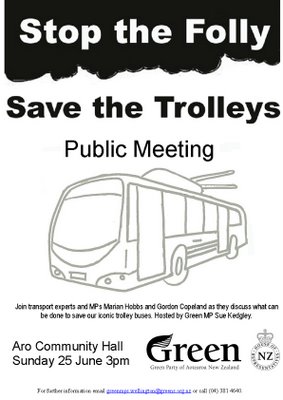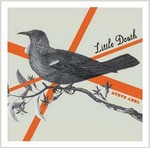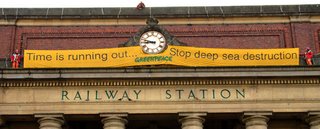Thursday, June 29, 2006
Taser Footage.
Check out scoop's:
Taser Podcast
They use taser manufacturers promotional footage and real life footage provided by campaign against the taser and blend it all together. Scoop presents a neutral standpoint but I think the evidence presents a strong argument about arming the New Zealand Police with the taser. I would recommend watching it, as it's a real possibility that it will be used on people taking part in protests or activism and tragically on people with drug or mental health problems. The footage provided by campaign against the taser has been sent to every MP in New Zealand, and no longer can MPs hide behind the argument that they are just unaware of it.
For more info.
Campaign Against the Taser
Tuesday, June 27, 2006
What Wellington would look like with a 7m sea rise.
Raising the Gher
Tying it all together
Walkin the wall
Tying the walls on
Francie doing her bit
The glamorous inside with the water proof tarping under the floor boars and up the walls.
Jonah’s Wonderfully hot pot belly was installed the same day
With a kinky flue up through the middle
And here it is, one day transported, erected, heated, the SHV Gher/pleasure palace.
A shot of the site to finish
By Dan http://www.savehappyvalley.org.nz/blog/?p=82#comments
Saturday, June 24, 2006
Stopped the folly and saved the trolleys.
 It has just been announced by Greater Wellington Chairman Ian Buchanan that the purchase of the 60 new reburbished trolley buses is going ahead - in other words Wellington is keeping its trolleys!
It has just been announced by Greater Wellington Chairman Ian Buchanan that the purchase of the 60 new reburbished trolley buses is going ahead - in other words Wellington is keeping its trolleys!Over the last few years there have been many wrangles whether to keep the up-to-24-year-old trolley buses on the roads; who would pay and how much for a fleet upgrade; how much to pay for an urgent lines upgrade; the inequal funding ratios between diesels and trolleys leading to a Greater Wellington shortfall; and lastly commerce commision inquiries.
But in the end, simple common sense prevailed and our clean, green and quiet trolleys buses are here to stay for the foreseeable future and when Project West Wind comes on board, the buses will be powered by our region's famed asset - the wind. The 60 trolley buses on our roads save 600 000 litres of diesel! That's a lot of foreign exchange, street level exhaust fumes and greenhouses gases from insecure supply sources avoided!
So the public meeting this Sunday 25 June 3pm has been cancelled. However, we will be holding a meeting in the near future to discuss wider transport issues in the Wellington region, and will attempt to achieve a cross-party consensus on the necessary improvements to Wellington's transport future.
Thank you very much to all those who helped out on the campaign - signing petitions, holding stalls and writing letters to the editor. In the end, much like how the trolleys were saved in the early 1980s, it came down to public pressure on the decision makers to stop the folly, save our trolleys!
For more information see Greater Wellingtons press release
http://www.gw.govt.nz/story17535.cfm
Hopefully you won't be hearing much from me anymore on the trolley buses. Anyone (if they did), coming to this site would assume that I am a trolley bus nut and absolutley mad about them....I'm not. Yeah I'm fond of them and I think losing them would of been a real step backwards for Wellington. I've enjoyed campaigning on them over the last 6 weeks and am happy to get a victory on them. However saving the trolleys has been about keeping what we've already got and not about significantly or even, improving public transport in Wellington and NZ's climate situation.
So next on the list. I am goping to be working on the Northern corridor light rail propossal and would like to investigate the possibility of changing diesels for the better and running them on biofuels.
Thursday, June 22, 2006
Trolley Bus Public Meeting.
A History of Protesting in New Zealand.
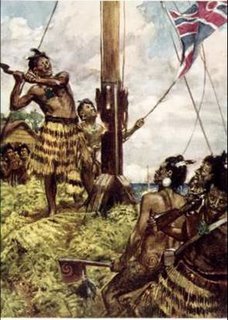 I started off my presentation by talking about Hone Hika, who cut down the flag pole at Russel, in the Bay of Islands, in the mid to late 1840s. He cut the pole down not once, not twice, but thrice. He also was a skilled soldier that took part in quite a few battles. I wanted to talk about non-violent protest but had to include this because I believe it was so important historically how he went after the symbols of power -such as the flag pole as a means to his ends.
I started off my presentation by talking about Hone Hika, who cut down the flag pole at Russel, in the Bay of Islands, in the mid to late 1840s. He cut the pole down not once, not twice, but thrice. He also was a skilled soldier that took part in quite a few battles. I wanted to talk about non-violent protest but had to include this because I believe it was so important historically how he went after the symbols of power -such as the flag pole as a means to his ends.I then talked about Parihaka, but not in depth because they had studied it the week before...what a cool class!

They were really keen on finding out about Greenpeace. It really is a cool story about how a bunch of hippies decided to charter a ship and sail it into an American nuclear test site in 1969. Greenpeace originally called this action a 'mind bomb, and they followed up their nuclear victory with the campaign against sealing. The above picture is of Greenpeace activists spray painting seal pups so that their fur would be useless to sealers. Again It's that attacking symbols again, like Hika, but with a direct action twist -it actually stops the crime continuing. Greenpeace brought this coherant theory of non-violent direct action to the World that was so important in New Zealand's most famous and successful protesting struggle -to make New Zealand nuclear free. Greenpeace also bore the ultimate cost when the Rainbow Warrior, was bombed killing photographer Fernando Periria.

The springbok apartheid protests showed another way of New Zealanders protesting that hadn't been seen since the massive strikes of the 1950's or the massive rounds of union protests that precceded both World Wars. Absolutley massive demonstrations and a political question that could split communities. It also showed some innovation that broke the monotony of march, struggle, dispersal -march, struggle, dispersal. Protestors dressed up as clowns or in the above picture a pilot is dropping flour bombs to disrupt the match at Eden Park in Auckland. Dangerous for use, but inovative.

I then gave a short workshop on different ways to stop something, as a means of protesting. One way, as pictured above is to chain your self to something, in this case an anchor, that is necessary for this ship to move, with it's cargo of genetically engineered organisms. There are other ways are to build barriers to stop something, they don't have to be sturdy -or could be made out of whale meat boxes, or sand bags or human -you can lock your self to a gate, in effect forming a wall, or just by linking arms a mass of people can form a wall that is pretty hard to move. Another way is put your self in the way of something and if they attempt to pass or continue they could hurt you. This was the theory the original Greenpeace crew was using. One activist used this theory by chaining himself to rail road tracks to halt the train and it's dangerous cargo...however didn't inform the train in time (and located himself around a bend), with predicable results. So to use this theory it is best to be well supported and public, such as the below picture.

This is called the tripod and is only effective against vehicles. By simply setting this up, no trucks can get through without seriously damaging you first, so that the authorities must use equipment such as cherry pickers to cut you off. This gives the activist hours of truck-stopping.
I think the students enjoyed the talk and asked a whole heap of questions. I am stoked to have gotten the oportunity to speak with them and I just wish we had had someone come and talk to my high school class about protesting.
Tuesday, June 20, 2006
Saving the Ugly Animals Too..
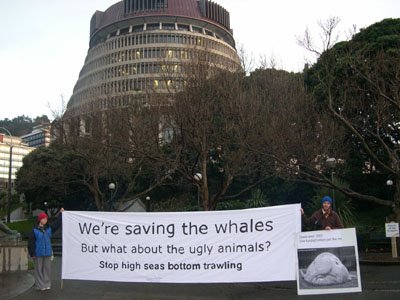
We're Saving the Whales – But What About the Ugly Animals?
Today several Wellington activists held a banner saying, "We're saving the whales, but what about the ugly animals? Stop bottom trawling." Together with the banner was a picture of a recently discovered blobfish. The activists stood outside Parliament gates, as they called on the Government to support the United Nation's efforts in the campaign for an international moratorium on high seas bottom trawling.
"Our Government has a strong stance on whaling which is commendable, yet it has a weak and hypocritical stance on bottom trawling." spokesperson Meghan Hughes said.
"We are making all the right noise at the IWC, but what's our Government doing about stopping the world's most destructive fishing method? We were world leaders toward the campaign to stop drift net fishing, however now that it is New Zealand vessels taking part in the destruction, our Government appears suspiciously inactive."
The New Zealand Government has refused to publicly support a moratorium on bottom trawling in international waters, a move that has the backing of environmentalists and marine scientists worldwide.
"We are highlighting the sorry performance of our elected officials to act on deep sea destruction. Whaling is a terrible and unsustainable industry still struggling from decades of overfishing; however bottom trawling is just as bad if not worse because of the habitat destruction made by dragging large nets along the ocean floor, and the effect that the practice has on the creatures that rely on that habitat for their existence." said Ms Hughes.
The blobfish was discovered only 3 years ago, and is part of what scientists believe is roughly one hundred million unidentified species living in the ocean's depths.
"This blobfish may appear an ugly and unusual character, but it is still deserves our protection." Ms Hughes said.
Extra Information.
Meghan Hughes can be contacted on 027 356 6603 or Gareth Hughes on 027 422 9290.
The banner will be outside Parliament gates (by the cenotaph) from 7:30-8:30am Tuesday, 20 June 2006.
Blobfish - Psychrolutes microporos
The blobfish is a scorpaeniform – a group of which contains the the most armoured and scaly and spiney spiked fish in the sea. The full range of this deepwater (750-1200m) fish is not yet known, this blobfish was collected at 1200m on the Southern Norfolk Ridge in the Tasman Sea. Scientists can only guess at how the fish feeds and based on its body shape is believed to be an ambush predator that will eat whatever it can fit in. The purpose of the proboscis (nose) is unknown. This fish was discovered on a NORFANZ expedition in 2003
Source:
http://censeam.niwa.co.nz/outreach/blobfish.pdfThursday, June 15, 2006
The Greens get another Bill pulled from the hat.
Parliament is to debate whether medicinal cannabis should be introduced as a treatment option for people with serious illnesses.
The concept forms the basis of Green MP Metiria Turei's private member's bill which has been pulled from the ballot. The Bill aims to amend the The misuse of drugs act (1975) and from here goes to the select commitee for further discussion.
Ms Turei says the bill will allow registered medical practitioners to prescribe cannabis for specific serious conditions such as Alzheimer's disease, arthritis, glaucoma and those suffering conditions associated with chemotherapy.
Perhaps this issue will spark wider debate on the decriminalisation/legalisation of cannabis both within the Green Party and wider society.
Medicinal cannabis is available in a number of countries - including Canada, Germany, the Netherlands and nine states of the US.
Wednesday, June 14, 2006
Steve Abel's Little Death.
Friday, June 09, 2006
What would Jesus do?
How to Make Paneer.

I made paneer last night and it was suprisingly easy.
Heres the recipe:
2 litres of milk
4 tsp lemon juice
Bring the milk to the boil -watch it 'cos it creeps up fast
Add the lemon juice (or vinegar) and stir for around 3 minutes until the milk curdles (til it looks like cottage cheese)
Strain liquid through a tea towel and put pressure on the curds (i,e; hang for thirty minutes), then put under a heavy weight for around an hour -to make sure you get all the liquid out of paneer.
Then either fry or refrigerate. Yum.
Thursday, June 08, 2006
Happy World Oceans Day
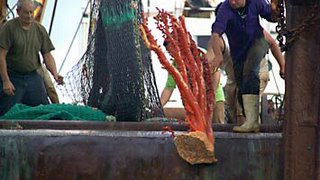
Bottom trawling is without a doubt the most damaging form of fishing we are using at the moment. Huge nets are dragged across the sea floor picking up and destroying all within its way- such as this giant gorgonian coral (pictured) that I saw being thrown over board by New Zealand bottom trawlers in International waters
Read about my voyage.
Send a message to Prime Minister Helen Clarke.
The Trawl is in your court, Greenpeace tells Government
Wellington, Thursday 8 June: Greenpeace New Zealand marked World Oceans Day by hanging a large banner across the front of Wellington Railway Station during the morning commuter rush with a message to the Government: "Time is Running Out - Stop Deep-Sea Destruction".
Three climbers scaled the Railway Station with the banner, while commuters walked past sculptures of tree-like corals and weird and wonderful deep-sea creatures.
For the past three years, Greenpeace has been exposing the destruction of bottom trawlers - including New Zealand vessels - in international waters. Over this time Greenpeace has reiterated that 'urgent action' is needed to protect the deep-sea life that scientists say are being pushed to extinction before they are even named.
"The only effective action is a United Nations moratorium on bottom trawling in international waters, but the New Zealand Government's approach has so far been weak and is a hindrance to progress at the UN," says oceans campaigner Mike Hagler. "Instead of leading the push for a UN moratorium, as our Government did with high seas drift netting in 1989, New Zealand is dawdling in the face of extinctions in the deep sea."
"Many countries see New Zealand as a global leader on environmental issues. Without clear and vocal support, the wrong signal is being sent to other countries that are also sitting on the fence. New Zealand needs to actively support the proposal with the intention of bringing other countries with it."
The proposed UN moratorium on high seas bottom trawling has the support of the world's scientific community and now 30 countries, including Sweden, Germany, Indonesia and Brazil.
"Every four seconds marine life in an area of ocean floor the size of ten football fields is wiped out by bottom trawlers in international waters. We want an approach that prevents the irreversible impacts of bottom trawling and protects vulnerable habitats, rather than trawl now, think later."
At present there are about 250-300 high seas bottom trawlers – including about two dozen New Zealand trawlers. This is only 0.3 percent of the three million commercial fishing boats worldwide, and only 0.2 percent of global marine fisheries production. The overall contribution of high seas bottom trawling to global food security is negligible.
Huge bottom trawl nets are bulldozed along the seabed taking all fish, smashing ancient corals and destroying the other marine life that has taken thousands of years to develop.
"Our message to Government is that time is running out for deep-sea life threatened by bottom trawling in international waters. A temporary halt to the practice, imposed by the UN, would buy time to put in place policies and regulations for long-term protection of deep-sea life".
Before World Oceans Day ends, a global fleet of around 300 high seas bottom trawlers will have dragged their heavy nets across an estimated 1,500 km2 of deep-seabed.
For more information contact:
Oceans Campaigner Mike Hagler 021 321 379
Communications officer Dean Baigent-Mercer 021 790 817
Wednesday, June 07, 2006
Saving our Trolley buses
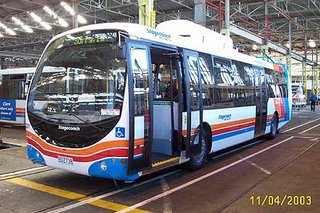
Currently there is a wrangle over their future in Wellington for several reasons. The Volvo buses really are nearing the end of their life and there is a plan to upgrade the entire 60 trolley bus fleet, however Stagecoach (who runs the buses) has been unable to sign the contract, because Land transport New Zealand and the Greater Wellington regional Council (Who fund the buses), are currently refusing to guarantee funding. LTNZ's reason is because they believe Stagecoach has a monopoly and would prefer the cheaper diesel option ($300 000 per diesel bus vs. $500 000 refurbished trolley bus), and GWRC because they have a funding shortfall of roughly $ 1 million (because LTNZ will only fund the operating costs of the trolleys as if they were diesels (so not paying for maintenance and urgent upgrade needed for the overhead wires and substations etc)
Basically because they have been under funded over the previous decades, large lump sums are needed from tax and ratepayers, and some public officials are calling for them to be scrapped all together, rather than front up with the needed costs or show leadership and decisively sort this issue out.
However with a large new wind farm going through the official process at the moment, (project West Wind, which will supply 110 000 homes -or all of Wellington) and very likely to proceed; it is possible for Wellingtons trolley bus fleet to be powered by (on average entirely) renewable energy, which is a great selling point in this age of climate change and rising oil prices.
There are a lots of reasons why the trolley buses are better than their diesel alternatives.
They don’t release diesel exhaust fumes
They are quieter
They are cleaner
They are iconic - Auckland and Dunedin got rid of their trolley bus fleets in the early 80s and now only Wellington has them in NZ. They are a symbol of a sustainable approach to transport.
They last longer -their engine life is perhaps as much as twice as long because the electric motor is more efficient than the diesel engine.
Our trolley fleet of 60 buses saves 600 000 litres of diesel - that’s a lot of foreign exchange and C02 emissions saved.
Tuesday, June 06, 2006
Future Proofing our Party: Gareths speech to Green Party AGM
Kia Ora
My name is Gareth Hughes and I am a young Green. I am passionate and excited about the role that Young People can play in the Green Party of Aotearoa New Zealand. Over the preceding months we have been meeting electronically and on frequent conference calls. On Friday a group of young people met at parliament to discuss how we can best become involved in environmental and social campaigning within the green Party. Young activists travelled from around the country to discuss what it is to be a young green in Aotearoa/New Zealand and where to from here. And today I am pleased to announce the formation of the young Greens. This afternoon you will hear Ben, who will be speaking on the story so far, and what we have done; then Tara will discuss our new structure; followed by Max who will speak on our policies. Shaun will speak on our goals for the coming year then Marcel will discuss our expectations of the Green Party.


